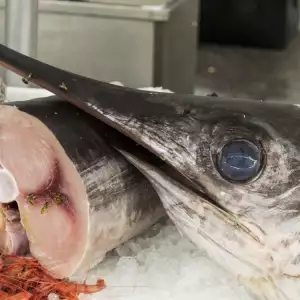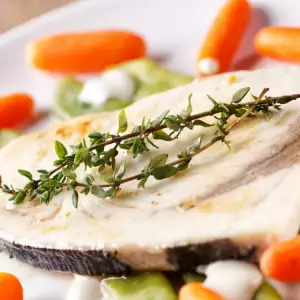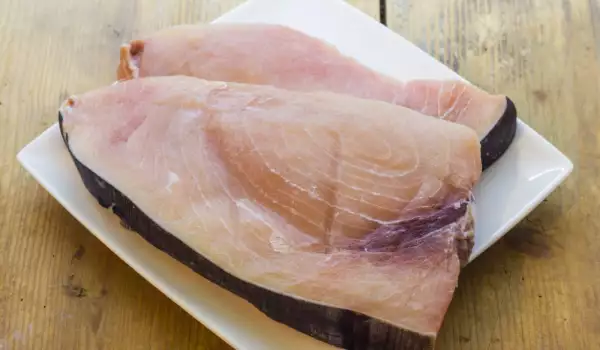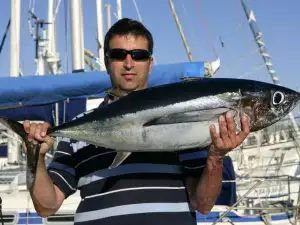The swordfish (Xiphias gladius) is a predatory fish from the Perciformes order that is especially popular because of its characteristic appearance. The swordfish possesses quite a long bill, resembling a sword, hence its name. The remarkable thing is that its upper jaw is about 1/3 its total body length. Adults of this species do not have any teeth.
Other characteristics of the swordfish include its large size. It reaches up to 14.8 ft (4.5 m) in length and can weigh up to 1433 lb (650 kg). It has a long body and long fins. Its back is tinged black or blue, sometimes dark brown. In some species, the back may be in different nuances of color. The belly area of the swordfish is colored silver or white.
Swordfish Behavior
Swordfish predominantly inhabit the Atlantic, Indian and Pacific oceans, where the waters are warm. It can also be found in the Mediterranean Sea. Swordfish swim in the epipelagic zone (the uppermost layer) of the ocean, making it easy for fishermen to spot.
They consume small fish like anchovies. Other fish it feeds on include mackerel, hake, bluefish, sardines and squid and octopus. Swordfish are most frequently spotted out in the open seas. It migrates often, following the schools of fish it intends to attack. It does use its bill to attack prey. Reaching up to 80 miles (130 km) per hour, it is considered the fastest fish in the world.
It is known for its impressive jumps over the water. Another attractive ability is how it can rapidly change the colors of its body. When excited, the swordfish becomes a canvas of all sorts of hues. The process is controlled by its nervous system. This gift also helps it catch its prey more easily. Swordfish are solitary swimmers.

If individuals swim together, the distance between them is quite long. The swordfish reproduces by floating roe. The fish release their roe in the open seas. Each tiny egg is between 1.5 and 1.8 mm in diameter. After 3 days at the latest, fry emerge from them, each one about 4-5 mm long. They are ravenous, eat well and bulk up very quickly.
The swordfish is lithe and agile. It follows its prey persistently and skillfully uses its sword. Sometimes, representatives of the species end up going after small vessels by accident. Scientists believe that the fish poke through the undersides of small boats while caught up in the pursuit of their prey.
When on the hunt, the predator swims at high speed and strikes the vessel with tremendous force. Such events apparently attract a lot of interest, since the British Museum in London even has a section with boat fragments containing the upper jaws (swords) of swordfish.
Catching Swordfish
Catching swordfish is a unique adventure for fishermen. It is a laborious task and is not recommended for the inexperienced. Special fishing rods and reels are used since the swordfish is an exceptionally energetic and feisty fish.
Artificial bait is used, which can be bought at specialized stores. The color is not of high import, even though some experts recommend bright and saturated colors. You will need a boat if fishing for swordfish, experts recommend a non-motorized one.
Fishermen also prepare thick gloves, since the sword is extraordinarily sharp in younger specimens, while at the same time the fish are aggressive and wily. The highest concentrated populations are found off the coasts of Japan and the Mediterranean. Fishing for swordfish can also be done in the Sea of Marmara.

Composition of Swordfish
The swordfish is a rich source of a lot of healthy substances. These include omega-3 and omega-6 fatty acids, sodium, vitamin A, vitamin B6, vitamin B12, vitamin E, vitamin K, calcium, iron, thiamine, magnesium, zinc, phosphorus, copper, selenium and others.
Cooking Swordfish
Usually, swordfish are caught due to the fact that the process provides exciting sport for experienced fish. The meat itself is tough and dense. A plus is that it does not contain small, hard-to-find bones. It can be cooked in a variety of ways.
Amazing fillets are made from the fish, which can then be grilled or baked in the oven. Breaded swordfish is also quite appetizing. Preparing it smoked or marinated are other suitable methods. Swordfish makes the perfect combination with eggplants, potatoes, carrots, onions and tomatoes. Spices suitable for it are dill, parsley, tarragon, oregano, black pepper, marjoram and others.
Benefits of Swordfish
The consumption of swordfish provide great benefits to our body since the meat is loaded with healthy substances, including essential amino acids and minerals. Eating swordfish has good overall benefits and is especially recommended for the cold winter months.















Comments